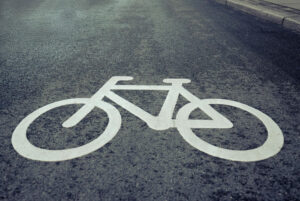Lower Speeds Safer for Cyclists – Easier Said Than Done!
“Lower speeds are safer for cyclists” seems like an obvious statement, but it’s not so easy to lower posted speed limits on state-controlled highways. Local public works agencies are often similarly reluctant to post lower speed limits when it appears that lower operating speeds seem clearly warranted.
The NH Department of Transportation follows the Federal Highway Administration’s Manual on Uniform Traffic Control Devices when determining speed limits. The Manual’s guidance states, “when a speed limit within a speed zone is posted, it should be within 5 mph of the 85th-percentile speed of free-flowing traffic.” Consider, for example, that the speed limit is currently posted at 40 MPH. If a speed assessment finds that 85% of motorists choose to travel at 50 MPH or more, the posted limit may be raised to 50 MPH.
Part of the purported logic behind using the 85th percentile speed is that setting the limit lower than the fastest 15% of motorists choose would result in disparities in actual travel speeds since some people will travel at the speed that they prefer to travel while others will slow down to the posted speed limit. That disparity introduces conflict. From the standpoint of cyclists and other vulnerable road users, increasing speed limits seems counterintuitive and increasingly dangerous. This form of logic essentially allows the 15 most reckless motorists out of 100 to determine their own operating speed. Worse, the 85th percentile speed methodology guarantees a continuous feedback loop of increasingly higher speed limits and operating speeds – i.e. higher speeds/higher postings/higher speeds. Reliance on the 85th percentile speed approach prioritizes the comfort and convenience of motorists over the safety of other road users.
BWANH wants to explore the question: Should NHDOT allow communities to post speed limits below the 85th percentile if the context justifies it? Examples where local road agencies may want to post lower speed limits might include village, residential, or urban contexts.
The League of American Bicyclists recently published “State of Speed Bills in 2023: Slower Speeds Create Safer Streets for Cyclists.” The article highlights states that have passed laws that help, and those that don’t help communities to control speed and safety. An earlier article on the LAB website, “Why Can’t My Street’s Speed Limit Be Changed?” provides a bit of background.
BWANH Board Member Larry Keniston, P. E. notes, “Setting safer, ‘unrealistic’ speed limits is one effective way to slow traffic because by definition, ‘unrealistic’ speed limit signs bring uncertainty to the roadway environment. We will never tackle motorist speed and safety issues until we see the disruption of traffic ‘flow’ as a good thing, not a bad thing. There are many other disrupting elements that we could incorporate into highways, such as bulb-outs, roundabouts, vertical deflection, horizontal deflection, narrow pavements, street trees, limiting sight distance, limiting laws against jaywalking (and other so-called walking ‘offenses’), eliminating multiple lanes and auxiliary lanes, limiting the size of ‘clear zones,’ employing short blocks, converting one-way streets to two-lane/two-way streets, adding gateways, increasing pedestrian and bicycle activity, on-street parking, etc.” Posting lower speed limits, therefore, is only one of many highway elements that can contribute to creating safer travel for all. A complete-streets traffic calming initiative, coupled with lower posted speeds in combination, will change motorists’ choice of speed, save lives, enhance local business traffic, and help make people more comfortable to cycle and walk in the public space.
Bethlehem, through the North Country Council, recently embarked on a traffic calming test. The goal was to narrow the street through bump-outs along the downtown area as well as installing speed feedback signs and sharrows. A full report summarizing the results will be made available, but preliminary results so far appear favorable.
In addition, BWANH is going to review the potential for initiating legislation that would enable towns to set lower speed limits on state-maintained roads, rather than leaving it solely to the NHDOT. Other organizations have already expressed interest in partnering on these efforts, and if we head down that path, we hope you’ll be there to support the initiative with us. Please let us know your thoughts by contacting info@bwanh.org.



